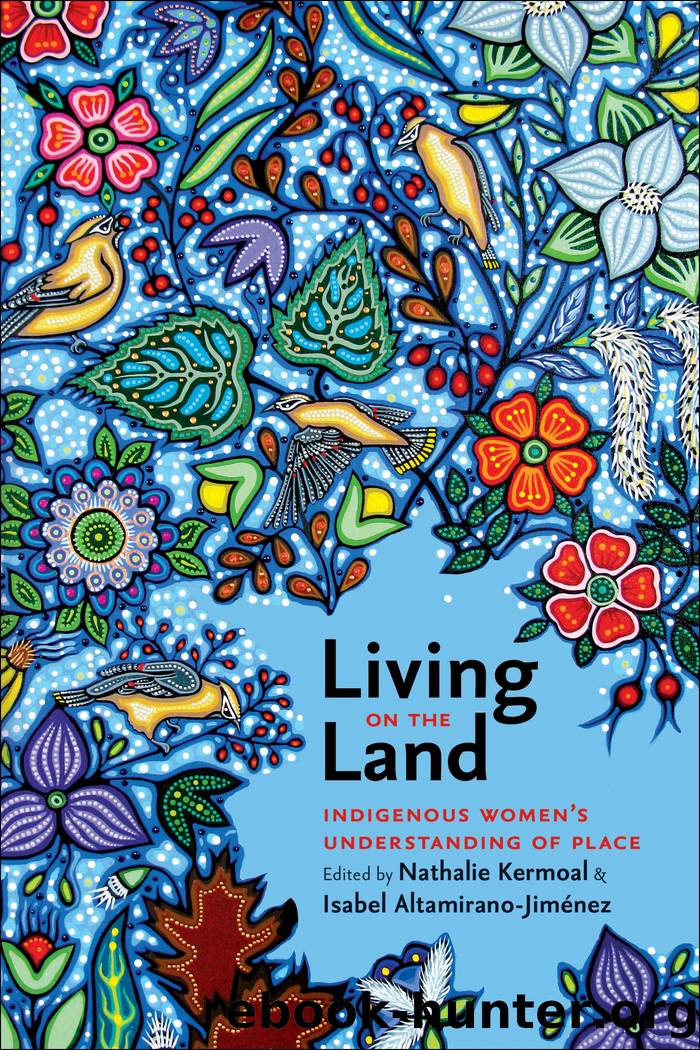Living on the Land by Nathalie Kermoal & Isabel Altamirano-Jiménez

Author:Nathalie Kermoal & Isabel Altamirano-Jiménez [Kermoal, Nathalie & Altamirano-Jiménez, Isabel]
Language: eng
Format: epub
Publisher: Athabasca University Press
Published: 2016-03-15T00:00:00+00:00
âOUR LAND IS OUR LIFEâ
Words such as displacement, dispossession, and migration are often used to describe the experiences of the Métis people after the events of 1869â70 at Red River, in present-day Manitoba. The events were triggered by the Hudsonâs Bay Companyâs transfer of the vast northwest territory of Rupertâs Land to the Canadian government without prior consultation with the peoples who lived on these lands. Concerned, the Métis, through a provisional government led by Louis Riel, negotiated terms for entering Confederation. As a result of these negotiations, the province of Manitoba was created by the Manitoba Act (1870). Section 31 of the Manitoba Act promised the Métis 1.4 million acres of land, to be redeemed in the form of scripâgovernment-issued certificates good for land or a cash equivalent. Because this system operated by doling out individual parcels of land (for which the Métis were obliged to compete with white settlers), it effectively denied the Métis a collective land base. Over a period of roughly fifty years, moreover, the Métis lost most of the land promised to them, chiefly at the hands of white speculators who cheated individuals and families out of their scrip.7
After 1870, the Métis were made to feel strangers in their own land. From the late nineteenth century onward, landless Métis moved from one locale to another across the Prairie provinces, endeavouring to eke out a livelihood. Some families moved further west while others relocated in other areas in Manitoba. Many new Métis communities were founded, but even these were not immune to actions on the part of government, and the Métis themselves were often the target of racial discrimination. Early in the twentieth century, for example, a number of Métis families founded a community at Ste-Madeleine, in western Manitoba. As was often the case, the community was located on lands that were not especially well suited to agriculture. All the same, after Parliament passed the Prairie Farm Rehabilitation Act in 1935, which was intended to encourage drought-stricken white farmers of the Depression era to remain on the prairies and continue to farm, the Métis from Ste-Madeleineâperceived as âsquattersââwere forced to relocate, and their community was burned (see Zeilig and Zeilig 1987). While the events at Ste-Madeleine are perhaps an especially egregious example, they are part of a well-recognized pattern of dispossession.
Yet despite this history of displacement, Métis people have maintained a very strong connection to the land and, more generally, to the Northwest, carrying with them knowledge systems integral to their culture. In âMétis and Feminist,â Emma LaRocque (2007, 57) speaks of the experiences of her people, the Apeetowgusanuk (or âhalf-sonsâ in Cree), and their deep emotional attachment to the land:
My parents, aunts and uncles all spoke of âscripâ and how Apeetowgusanuk lost and were continuing to lose beloved domains of lands either through scrip or simply through urban, industrial and farming encroachments. Legally, we did not own any land but in those years we could still definitely live on, from and with the land, for morally, it was our land.
Download
This site does not store any files on its server. We only index and link to content provided by other sites. Please contact the content providers to delete copyright contents if any and email us, we'll remove relevant links or contents immediately.
What's Done in Darkness by Kayla Perrin(25500)
Shot Through the Heart: DI Grace Fisher 2 by Isabelle Grey(18219)
Shot Through the Heart by Mercy Celeste(18160)
The Fifty Shades Trilogy & Grey by E L James(17774)
The 3rd Cycle of the Betrayed Series Collection: Extremely Controversial Historical Thrillers (Betrayed Series Boxed set) by McCray Carolyn(13189)
The Subtle Art of Not Giving a F*ck by Mark Manson(12912)
Scorched Earth by Nick Kyme(11832)
Stepbrother Stories 2 - 21 Taboo Story Collection (Brother Sister Stepbrother Stepsister Taboo Pseudo Incest Family Virgin Creampie Pregnant Forced Pregnancy Breeding) by Roxi Harding(11040)
Drei Generationen auf dem Jakobsweg by Stein Pia(10217)
Suna by Ziefle Pia(10186)
Scythe by Neal Shusterman(9260)
International Relations from the Global South; Worlds of Difference; First Edition by Arlene B. Tickner & Karen Smith(8608)
Successful Proposal Strategies for Small Businesses: Using Knowledge Management ot Win Govenment, Private Sector, and International Contracts 3rd Edition by Robert Frey(8419)
This is Going to Hurt by Adam Kay(7695)
Dirty Filthy Fix: A Fixed Trilogy Novella by Laurelin Paige(6453)
He Loves Me...KNOT by RC Boldt(5804)
How to Make Love to a Negro Without Getting Tired by Dany LaFerrière(5378)
Interdimensional Brothel by F4U(5304)
Thankful For Her by Alexa Riley(5161)
